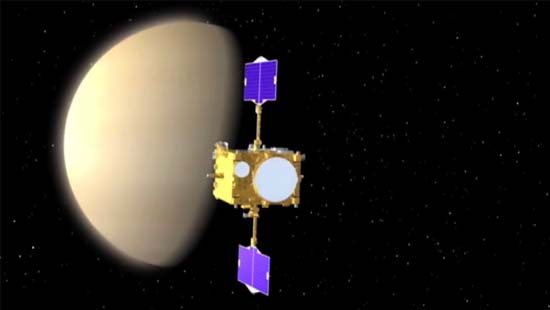Venus Data Sheet

Please see our updated Venus Reference Page.
More Information on the Planet Venus
The second planet from the sun bakes under twice as much solar radiation as Earth and reaches temperatures of 895 degrees Fahrenheit (480 degrees Celsius). Pressure from the dense atmosphere of sulfuric acid gas is about 95 times greater than Earth's and would crush a human.
The thick cloud cover around Venus rotates much faster than the planet itself — once every four days. After the moon, Venus is the brightest object in the sky.
The surface of Venus is mostly a rocky desert (this computer-generated view shows lava flows around Sif Mons). Like Mercury, Earth and Mars, Venus is composed of mostly rock and metal.
Venus data (averages):
Diameter: 7,521 miles (12,104 kilometers)
Time to rotate: 241 days
Orbit: 225 Earth days
Breaking space news, the latest updates on rocket launches, skywatching events and more!
Compared to earth:
Mass: 82% of Earth's
Diameter: 95% of Earth's
Distance from Sun: 70% as far
VENUS: ROMAN GODDESS OF LOVE AND BEAUTY
Historical notes
The Greeks believed Venus was two separate objects — one in the morning sky and another in the evening. Because it is often brighter than any other object in the sky — except for the sun and moon — Venus has generated many UFO reports.
Final facts
While all of the planets orbit in an ellipse, Venus' orbit is the closest to a perfect circle. It is the only planet in the solar system whose day (241 Earth days) is longer than its year (225 Earth days).

Space.com is the premier source of space exploration, innovation and astronomy news, chronicling (and celebrating) humanity's ongoing expansion across the final frontier. Originally founded in 1999, Space.com is, and always has been, the passion of writers and editors who are space fans and also trained journalists. Our current news team consists of Editor-in-Chief Tariq Malik; Editor Hanneke Weitering, Senior Space Writer Mike Wall; Senior Writer Meghan Bartels; Senior Writer Chelsea Gohd, Senior Writer Tereza Pultarova and Staff Writer Alexander Cox, focusing on e-commerce. Senior Producer Steve Spaleta oversees our space videos, with Diana Whitcroft as our Social Media Editor.
